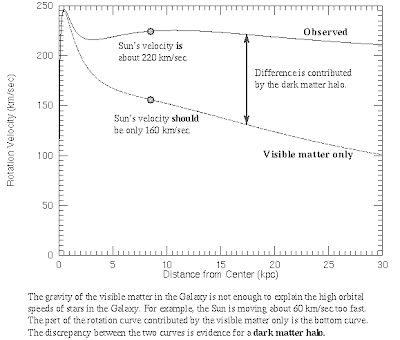Prior to about ten years ago, there was a bit of trouble in cosmological circles…only a bit! About three-fourths of the matter of the Universe was "dark" or "unobserved". Then in 1998, the phenomenon that faraway exploding stars seemed to be too dim caused all hell to break loose: it seems that cosmic expansion is speeding up! Theorists have had a field day every since, and the current model accepted by a slight majority of cosmologists is that "dark energy" makes up 70% of the total mass-energy of the Universe, "dark matter" makes up 26%, and "ordinary matter" the stuff we can see with telescopes (visual, radio, x-ray, etc.), makes up just 4%.
The strange thing is, "dark energy" doesn't add to the gravitational pull on space that the matter, dark and otherwise, is exerting. Rather, it is counteracting it, and seems to have "recently" overcome it. But it isn't causing "local" gravity to reduce to any measurable extent.
 This chart, cribbed from a homework assignment at Butler University, shows one piece of evidence for "dark matter". Retired professor John W. Moffat has devised a theory of gravity that doesn't need dark matter to explain the rotation function of our Galaxy, or any other. In his new book Reinventing Gravity: A Physicist Goes Beyond Einstein, he outlines his theory. His explanation is quite lucid without invoking any math. That's a good thing, because cosmological math is formidable.
This chart, cribbed from a homework assignment at Butler University, shows one piece of evidence for "dark matter". Retired professor John W. Moffat has devised a theory of gravity that doesn't need dark matter to explain the rotation function of our Galaxy, or any other. In his new book Reinventing Gravity: A Physicist Goes Beyond Einstein, he outlines his theory. His explanation is quite lucid without invoking any math. That's a good thing, because cosmological math is formidable.I'll take it that he knows how to do his math. And he is not working alone. He has a number of collaborators, and together they've worked out a hypothesis he calls the Modification Of Gravity, or MOG. There are two parts to it. The first part makes the gravitational constant G not so constant; it depends on distance and total acceleration. The difference between the two curves above indicates that the dependence on distance must mean the effect is negligible over less than a few thousand parsecs (a parsec is 3.26 light years). Fortunately, the change is asymptotic, or over millions of light years it might grow sufficiently large to collapse the Universe in short order!
The second part of MOG is a fifth force, carried by a postulated new particle. Its dependence on distance is even more gradual, and it operates as a kind of antigravity to cause the universe's expansion to accelerate, as the supernova data indicate is happening. However, he will cheerfully drop this part of MOG if it is found that accelerated expansion is not really happening.
The first third of the book is a historical survey of cosmology and of Einstein's General Theory of Relativity, or his Gravitational Relativity Theory. In particular, he dwells on the Copernican/Keplerian revolution that did away with the need to have Epicycles to explain the orbits of the planets. He thinks the proliferation of complex theories going on now are mostly "modern epicycles". I agree. A theory like "superstrings", that makes to testable predictions and can be formulated in an infinite number of ways, is no theory at all in my mind.
And I have my own question to ask about the supernova data. Type Ia supernovae are supposed to be "standard candles". They occur in a standard way: an aging star feeds mass to a companion white dwarf star, which finally collapses at a specific weight. This seems to be a function of the triggering mass and nothing else, but it is only
The very earliest stars were very pure H/He stars, and during their "main sequence" existence, they behaved differently than stars with larger amounts of heavier elements. Specifically, stars of any given mass that have more "metals" burn hotter. I wonder if, in the same way, the more "metallic" star stuff dumped on a white dwarf by a later-generation star might give its detonation more oomph, compared to the earliest-generation stars that we are seeing in these "accelerating universe" data. I don't believe Ia "standard candles" are all that "standard".
I am glad Dr. Moffat was able to get this book into print. So often, the "orthodox science" (what an oxymoron!) and its defenders keep dissenting views out of public view. This is too big (!) an issue to be kept under wraps. I don't understand Einstein or any of them in more than a "gut feel" way, but I am glad that bright people are laboring away to figure these things out.



No comments:
Post a Comment